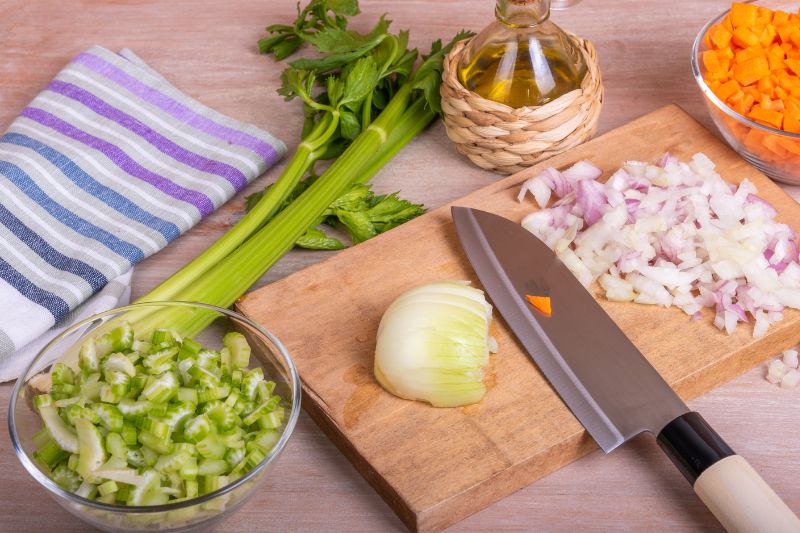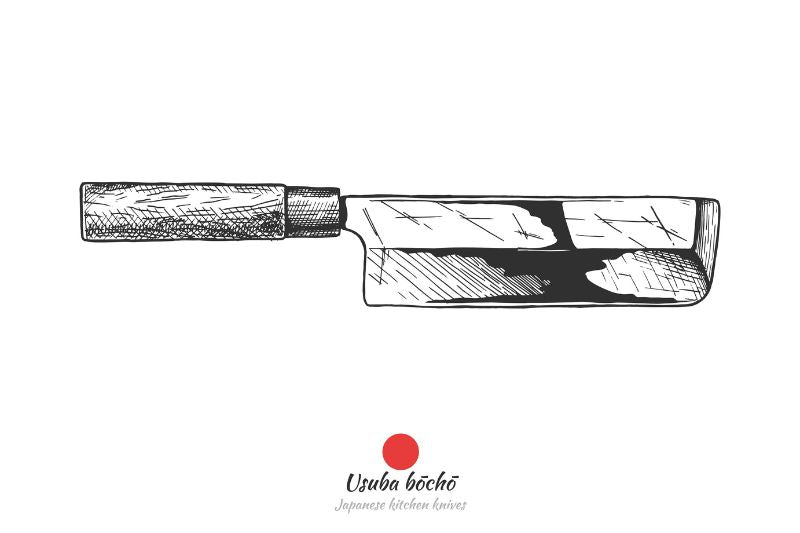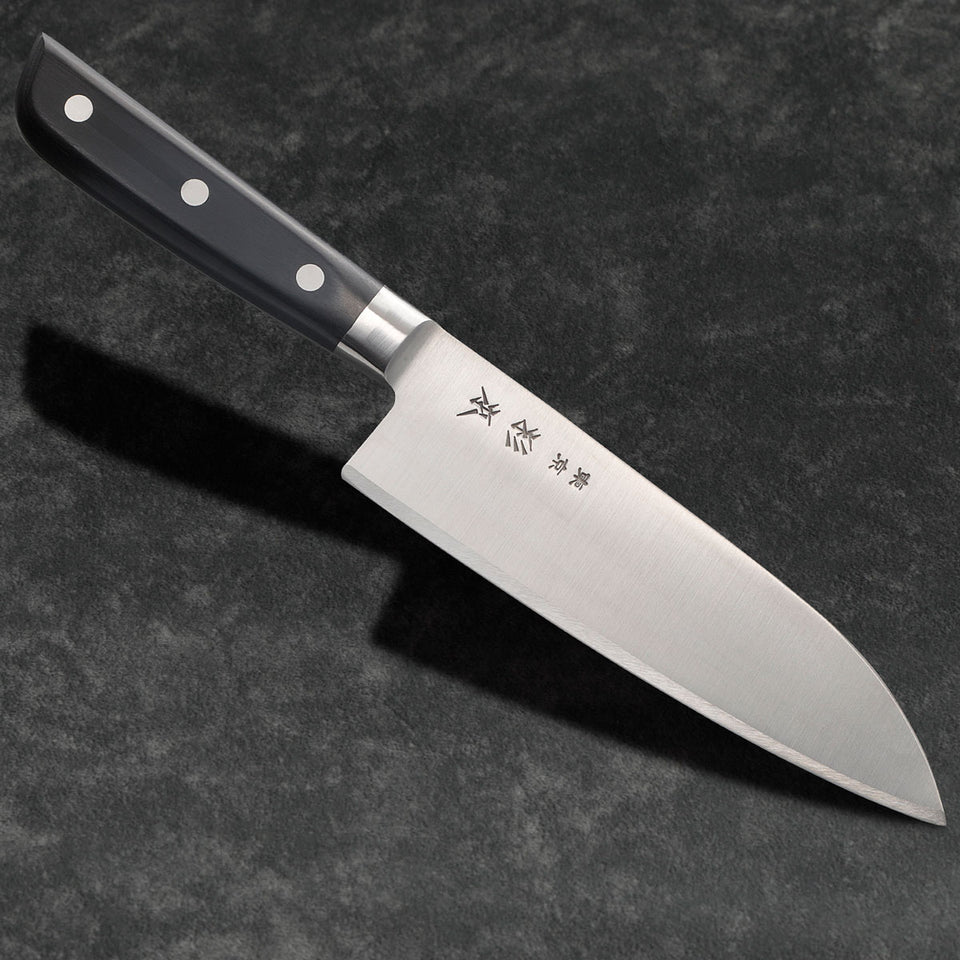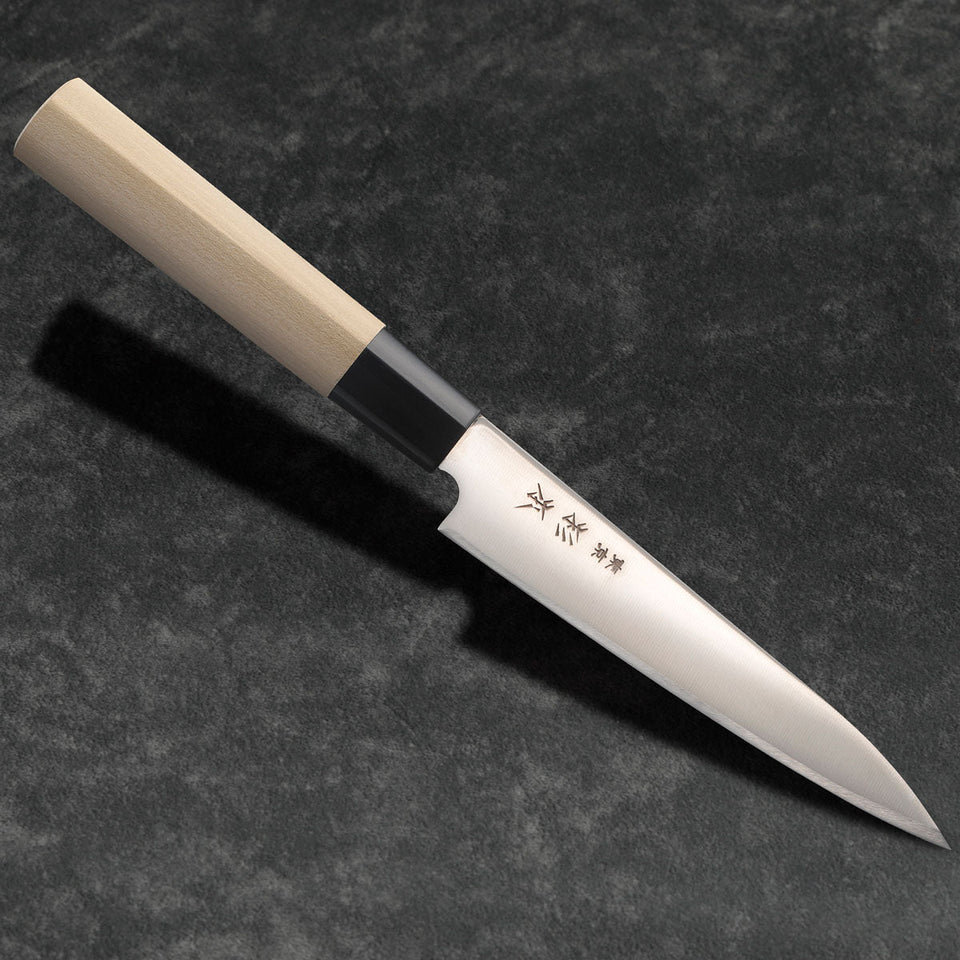Have you ever had a Chef vs. Vegetable moment in the kitchen? I certainly have. It's that unforgettable moment when your knife decides it wants to play "Hide and Seek" with the onion's layers, leaving you in tears of both frustration and, well, onion-induced sadness. Or when those stubborn root vegetables (think beets, celeriac, lotus roots, and yes, even carrots when they feel like it) exhibit a superhero-level resistance, bending or, heaven forbid, breaking or chipping your beloved knife. And let's not forget the chaos of the cabbage, where your cabbage is bigger than your knife and the cutting board, transforming your kitchen into a veggie battlefield.
I used to think this was primarily due to the fact that I am not a professional chef. But then, a revelation came knocking in the form of conversations with professional chef friends. To my surprise, they not only empathized but also confessed to experiencing these vegetable showdowns on the regular. The plot twist? They knew the secret recipe for victory: the right chef knives.

So, I embarked on a journey to unveil the culinary magic of Japanese chef knives and explore how they can transform even the most formidable of vegetables. Along the way, I consulted friends who work their culinary wizardry in plant-based, vegan, and vegetarian kitchens, where fruits and vegetables take center stage daily, dancing in an array of styles and shapes. The results? A wealth of knowledge.
To diversify the opinions on this matter, I also took it to the expertise of Reddit's knife community and the gatherings of knife enthusiasts on Facebook. I received a wealth of 'insider tips' from these communities. Now, it's my pleasure to share this knowledge with you.
Without further ado, let's embark on a journey together. We'll answer the burning questions about plant-based ingredients and knives, and I'll introduce you to the Japanese chef knives that I believe will be the game-changer your vegan or vegetarian kitchen has been waiting for.
Why Japanese Knives are uniquely suited to Plant-Based Kitchens
Japanese cuisine is renowned as one of the healthiest on the planet, characterized by a diet predominantly composed of vegetables, fish, fruits, and plant-derived ingredients such as Tofu, miso, and soy sauce, along with a delightful array of grains. However, there's another aspect that truly distinguishes Japanese gastronomy – its remarkable variety. Each time I return to Japan, the diversity of a typical Japanese meal never ceases to amaze me. Each meal in Japan is composed of three to five small dishes, each lovingly crafted with seasonal ingredients. This is where the role of knives comes into play.
When you're working with such diverse ingredients, you quickly realize that different tasks call for different knives. Japanese knives come to the rescue with distinct advantages that set them apart from the rest:
- Specialization: Japanese knives offer an extensive range of options, each tailored for specific vegetable cutting or prepping tasks. They're like the specialized tools in a craftsman's kit, ensuring precision for every culinary challenge.
- Versatility: Even the general-purpose Japanese knives are crafted to excel across a broad spectrum of vegetables. From the sturdy daikon radish to the delicate scallion, these knives perform admirably.
Let's dive into the world of Japanese plant-based ingredients that often put chefs to the test:
- Lotus Root (Renkon): This ingredient presents a unique challenge - it's hard, brittle, and stringy when raw, yet recipes often call for preserving its beautiful holes in thin slices.
- Myoga: This delicate ginger-like root demands careful handling.
- Hakusai (Chinese Cabbage): A larger, more substantial relative of cabbage that requires some extra chopping finesse.
- Gobo (Burdock Root): This ingredient is hard, lengthy, and requires meticulous scraping of its outer layer.

Beyond these culinary complexities, Japanese knives also excel in other aspects that make them the top choice for vegan and vegetarian chefs and kitchens:
- Efficiency in Prep Work: Japanese cuisine has a reputation for demanding a lot of prep work. It's often the initial duty for junior chefs in Japanese restaurants after they've "graduated" from dishwashing. This led to the evolution of Japanese knives designed for maximum efficiency, whether it's peeling, chopping, dicing, slicing, or even intricate cutting and scraping.
- Elevates the aesthetics, artistry, and presentation: One of the biggest joys for me when indulging in a plant-based meal is the vibrant colors that greet my plate. It's a symphony of natural beauty, reassuring that what's healthy can also be incredibly attractive. Japanese cuisine underscores this with
This cultural value is ingrained in the art of Japanese knife crafting, where every blade is a brush for the chef as the artist, meticulously designed for the fine, intricate, precise, and extremely detailed work that transforms ingredients into culinary art.
For more interesting write-ups on Japanese knives compared to Western knives, check these out:
Best Japanese Chef Knives for a Plant-Based or vegetable-focused Kitchen
As I introduce you to the best Japanese knife types for working with plant-based ingredients, I will try to keep it short and focused on the vegetable-cutting aspect of these knives. However, if you want to know more about each of the knife types, make sure to follow the links I have shared, as we have a thorough article written on these knives.
1. Nakiri: The humble but capable Vegetable Specialist (菜切り)

Nakiri is one of the must-haves in general for any chef’s knife drawer. However, Nakiri is also kind of a no-brainer just looking at its name: ‘Nakiri 菜切り[菜(Na)= Leaf/greens/veggies, 切り= Kiri = Cutter/to cut] and is a knife that has traditionally been made with the purpose of cutting vegetables.
(Hearing about Nakiri for the first time? No problem – take a moment to read this easy guide to Nakiri, and you can come back again.)
Here are some reasons why Nakiri is a must-have when it comes to vegetables:
-
Thin and lightweight: This is why many people prefer a Nakiri to a Usuba (more on Usuba below). Think of when you have to cut using a heavy knife such as a cleaver. Doesn’t your wrist and hand get tired very quickly? Nakiri, being super lightweight, allows you to be fast and do a lot of chopping, cutting, slicing, and dicing without getting tired quickly.
- Double-beveled: Double beveled blades are known for their versatility, being less prone to chipping due to their thicker blades, a more robust edge geometry, and user-friendly design. Their durability and resistance to chipping make them an excellent choice for a wide range of cutting tasks, including those involving harder or denser ingredients.
- Rectangular shape of the blade: Unlike a gyuto, there is no belly on the blade, and it is a very efficient push-cut with a large amount of the blade doing the chopping. Also, this makes it not only convenient and efficient but actually 'enjoyable and highly satisfying" to cut vegetables. Who knew prep work could be fun? The wider surface area compared to other knives, such as a bunka knife, is useful for scooping up chopped vegetables.
Examples of when they might be the best option:
- Chopping through a hefty amount of onions
- Making fine slices of carrots for a soup or salad
- Cutting root vegetables such as daikon radish, rutabaga, beets, etc.
2. Usuba Knife: The Single-Beveled Precision Master (薄刃包丁)

The Usuba knife, often dubbed the bigger cousin of the Nakiri, takes vegetable cutting to a whole new level, especially in professional kitchens where precision is paramount.
- For fine, detailed, precision-focused vegetable cutting: The name "Usuba" itself translates to "thin blade," hinting at the remarkable thin edge that sets it apart. This knife shines when it comes to cutting vegetables and fruits that are meant to be served raw. The thin and sharp blade minimizes cell damage, reducing discoloration and flavor changes due to oxidation.
- Thin and long blade: With its relatively tall and long blade, the Usuba is tailor-made for handling larger ingredients like cabbages. However, it's not the go-to choice for vegetables or fruits with tough skins or hard stones, as they can potentially damage the delicate blade.
- Extremely high professional-level precision: The Usuba knife is a traditional Japanese gem designed for precision and delicate slicing. Its single-bevel edge lends itself to exacting cuts, making it a favorite among professional chefs and sushi chefs. These knives are typically longer and heavier than their Nakiri counterparts, reflecting their suitability for meticulous and fine vegetable work.
To make things clearer, here's a handy comparison between the Usuba and the Nakiri, two excellent additions to any plant-based kitchen:
|
Features |
Nakiri |
Usuba |
|---|---|---|
|
Blade Shape |
Straight, flat cutting edge, rounded tip |
Thin and angular, flat cutting edge, rounded tip |
|
Blade Design |
Optimized for efficient vegetable cutting |
Optimized for precise and intricate vegetable cutting |
|
Bevel |
Double-beveled, symmetrical angle |
Single-beveled, asymmetrical angle |
|
Blade Material |
Carbon steel or stainless steel |
Carbon steel or stainless steel |
|
Weight |
Lighter |
Heavier |
|
Handle |
Made of wood, plastic, or other materials |
Made of wood, plastic, or other materials |
|
Ideal Use |
Chopping and slicing vegetables Good for volume processing of vegetables |
Precise and intricate cuts of vegetables Good for intricate artistic and food decoration work |
|
Examples of Use |
|
|
3. Santoku Knife: The Versatile Three Virtues Knife (三徳包丁)

The Santoku knife, whose name translates to "Three Virtues," embodies its versatility and excellence in being suitable for different kinds of ingredients used in Japanese cuisine: vegetables, fish, and meat. For example, Imagine crafting a vibrant vegetable stir-fry with bell peppers, zucchini, and Tofu. The Santoku knife's multi-purpose design ensures precision when dicing the peppers, control when slicing the zucchini, and ease in cubing the Tofu for a harmonious dish. This all-purpose Japanese knife is the ideal choice for plant-based kitchens for several reasons.
- Multi-Purpose Performance: Much like the Gyuto and Bunka knives, the Santoku's shorter and wider blade lends itself to a variety of kitchen tasks, from slicing and dicing to chopping. It's the ideal tool for tackling a medley of plant-based ingredients, including leafy greens like kale, fibrous root vegetables, and soft fruits such as tomatoes.
- Comfort and Control: The Santoku knife's balanced weight and ergonomic design ensure comfort and control, making it an ideal choice for extended chopping sessions. Whether you're finely chopping herbs for garnishes or cubing Tofu for a curry, the Santoku offers a seamless cutting experience, essential for plant-based kitchen enthusiasts.
More on Santoku here: What are Santoku knives used for?
4. Petty Knife: The Small But Mighty Knife (ペティナイフ)

In a plant-based kitchen, precision and versatility are key, and the Japanese Petty Knife, or "Petti Naifu," steps up to the plate with these attributes. Here's why it's a must-have for plant-based culinary enthusiasts:
- Versatile Precision: The Petty Knife is your go-to for precise tasks such as slicing, dicing, and mincing a variety of plant-based ingredients like vegetables, herbs, and fruits. Its razor-sharp double-bevel blade ensures accuracy in every cut.
- Compact and Practical: Designed to fit comfortably in your hand, the Petty Knife is compact and easy to handle, making it ideal for plant-based tasks like peeling and trimming. Its smaller size offers greater control for delicate work, ensuring you make the most out of your plant-based ingredients.
- Adaptable Blade Length: With blade lengths ranging from 80-180mm, the Petty Knife can be tailored to your specific needs. Opt for the 120-150mm range, which is perfect for most plant-based kitchen tasks. It strikes the right balance, providing ample cutting surface while remaining agile.
- A Bridge Between East and West: The Petty Knife harmoniously blends Western and Japanese influences, making it a versatile tool for plant-based cooking. Its profile, with a pointed tip and a flat heel, allows for precise cuts, from julienning to fine trimming.
5. Bunka Knife: When you can’t decide between a Gyuto and a Santoku (文化包丁)

When initially compiling our list, we were not so sure about its place in this list. However, our extensive research on social media brought it to the forefront as numerous users enthusiastically recommended the Bunka Knife for vegetable tasks.
The Bunka Knife is a true kitchen chameleon, seamlessly blending the attributes of Santoku and Gyuto knives. What sets it apart is its distinctive handle design, sloping diagonally in relation to the blade. This unique feature makes it ideal for a specific cutting method known as 'Tsukikiri.' With this technique, you effortlessly slice by applying a downward diagonal motion, all while maintaining a parallel alignment between the cutting board and the blade edge. For instance, when you're crafting delicate cabbage julienne, the Bunka Knife excels in providing a more comfortable and less fatiguing experience compared to its versatile counterparts.
Have more questions about the Bunka knife? Here's a comprehensive guide.
A summary of Japanese vegetable cutting techniques and which knife type to use
In Japanese cuisine, there are more than 40 different ways you can cut vegetables. There are also different techniques for peeling, scraping, or managing parts of plant-based ingredients, such as Katsuramuki (rotary peeling).
I am summing up some of the most commonly used Japanese vegetable cutting techniques in a table below, but keep an eye on our blogs and newsletters, as I am currently working on a comprehensive guide including ALL of these techniques, which I will publish when it is complete.
|
Technique |
Description |
Example Vegetables |
Ideal Use |
Suggested Knife Type |
|---|---|---|---|---|
|
Tanzakugiri |
Cutting into broad strips, then into plates |
|
Ideal for salad and soup |
Santoku Knife |
|
Hyoshigiri |
Cut strips into thick blocks |
|
Ideal for stir-fry and simmered dishes |
Nakiri Knife |
|
Sainomegiri |
Cubes with intervals |
|
Great for salads, side dishes, and cooked dishes |
Usuba Knife |
|
Sengiri |
Slicing in straws |
|
Versatile for decoration and various dishes |
Kamagata Usuba Knife |
|
Mijingiri |
Fine slicing |
|
Ideal for dishes like rice with chicken, spaghetti, and curry sauce |
Petty Knife |
|
Koguchigiri |
Thin cut across the fibers |
|
Ideal for fried dishes |
Deba Knife |
|
Sasagaki |
Shaving technique for burdock and carrots |
|
Used for preparing first dishes |
Yanagiba Knife |
|
Men-tori |
Smoothening sharp angles in thickly cut vegetables |
|
Ideal for festive dishes |
Kiritsuke Knife |
|
Kakushibocho |
Cruciform incisions to enhance cooking |
|
Great for dishes like stewed meat with vegetables |
Gyuto Knife |
|
Usugiri |
Thin slicing for crisp texture |
|
Ideal for simmered dishes, stir-fry, pickled dishes, and salads |
Santoku Knife |
|
Rangiri |
Rotating and cutting for increased surface area |
|
Ideal for digested dishes and stewed meat |
Nakiri Knife |
|
Hangetsugiri |
Slicing into semi-circles |
|
Ideal for simmered dishes and soups |
Usuba Knife |
Bonus Read: Here is an article on what type of knives to use for acidic vegetables.
What do the real-life knife users say? Opinions from real-life Japanese knife users who love vegetables
So here is the part of today's article that is very interesting. Not to say the rest of the article is not, but this part is unique because it is real-life opinions collected from Reddit and the Facebook knife-loving community.
While doing research for the post, I and my team have posted questions to Japanese chef knife communities and received tons of helpful and insightful responses that we will share with you below:
Discussion 1: Facebook:
Questions posted by us:

Comment Highlights:
- Recommended Nakiri with a blade length of 165 0r 180 mm, and also a cleaver
- Someone has used Gyuto and Yanagiba successfully for Katsuramuki (a very fine, detailed Japanese vegetable slicing technique that usually calls for Usuba)

Comment Highlights:
- A user who has been a vegetarian for over 30 years keeps these knives on his shelf:
- Gyuto
- Nakiri
- A mix of different Petty knives
- Santoku
- Bunka

Comment Highlights:
- A comment that mentions using Udonkiri to cut large cabbages:
I think this is one of the most interesting comments we received in our posts. This comment shows the beauty of how limitless Japanese knives are. Yes, there are basic rules, but as some say, 'rules are there to be broken.' Once you know how to use a specific type of knife without damaging it, we highly recommend experimenting with your knives. By the way, this is what a Udonkiri knife looks like.


The Udonkiri bocho, also known as Menkiri Bocho, is a specialized Japanese knife designed for a unique purpose: making Udon noodles (thick Japanese noodles made from wheat flour). This kitchen tool features a long, straight blade tailored for precise noodle-making. During Udon-making, the dough is meticulously flattened, folded, and cut into long, rectangular noodles using the Udonkiri knife. Its weight and design facilitate smooth, controlled cuts, often requiring a gentle forward motion. Well, today, we've also discovered that it's surprisingly adept at slicing cabbages, showcasing the unexpected versatility of this kitchen companion.
- Someone commented that they use a Gyuto for cutting cabbages
- Santoku in different shapes can be an alternative to having a Nakiri
- The important factors to consider before choosing a Japanese knife for cutting vegetables are Thickness, grind, and sharpness

Comment Highlights
- A knife that is thin behind the edge but has a flat belly seems to be great for vegetable preparation.
- A user commented that for herbs and vegetables, his favorites are the Tinker Tank (a knife that is a mix between a Chinese cleaver and an extremely large Bunka knife), Santoku, and a Bunka knife (especially for making super-fine chiffonnades).
- There has been some talk of 'grind,' but we decided it is better left for a different article where we will discuss 'grinds' in full detail.

Comment Highlights:
- Someone is happy with only a 240mm Gyuto as long as it is not used for smashing garlic. (Want to learn more about knife lengths? Head on to this article)

Comment Highlights:
- Most people have supported using Bunka, Santoku, and Nakiri.
Discussion 2: Reddit Post
Questions Posted by us:

Helpful replies:

What we learned from the Reddit replies:
- Gyuto for doing tasks such as cutting and creating chiffonade of chives
- 15 cm Petty Knife for Cutting super thin slices of shallots and garlic
- For this person, the holy trinity for vegetable-based cooking is – A tall Nakiri, 21cm Gyuto, and a 15cm Petty knife

- A Ko-Bunka knife or a Petty knife for shallots or garlic
By the way, What is Ko-Bunka? 'Ko' means small in Japanese, and Ko-Deba, as you have already figured, means a smaller version of a Deba Knife. (read more on Deba knife here). The petite, single-bevel Ko-Deba knife excels at filleting smaller fish like sea bream or horse mackerel (aji). However, its versatility extends beyond the fish filleting realm. It's your trusty companion for delicate kitchen duties, from effortlessly mincing herbs to precision work in cleaning and preparing vegetables.
- Another person prefers Chinese cleavers or Japanese Chuka Bocho over common Japanese knives. Ready to hear our take on Chinese knives vs. Japanese knives? Head onto this article.

- This person recommends Usuba and Nakiri but would not recommend Usuba for cutting through the tough skin of large, hard vegetables like pumpkin or squash.
So that was all from our knife enthusiast communities. However, we are not done yet. Keep on reading for some common questions we receive regarding the world of vegetables and Japanese chef knives.
Which is the best Japanese knife for cutting Tofu?
Tofu is one of the most versatile and delicious sources of protein in a plant-based kitchen. I personally am a big fan of Tofu in my miso soup. Let's take a look at which type of Japanese knife is best for cutting Tofu.
Cutting different types of Tofu requires specific Japanese knives for the best results:
- Firm Tofu: When working with firm Tofu, a Santoku knife is a great choice. The Santoku's versatility and sharp edge make it ideal for cleanly cutting firm Tofu into various shapes for stir-fries, grilling, or other dishes.
- Silken Tofu: For delicate silken Tofu often used in recipes like Agedashi dofu, a Nakiri knife is well-suited. Its thin, double-beveled blade allows for precise and gentle slicing without damaging the tender texture of silken Tofu.
- Extra-Firm Tofu: When you need to cube or slice extra-firm Tofu for recipes that require maintaining its shape during cooking, consider using a Yanagiba or Sujihiki knife. These knives have long, single-beveled blades that can handle the dense texture of extra-firm Tofu.
Which Japanese knife is best for cutting Konnyaku?
When it comes to cutting Konnyaku, a traditional Japanese jelly-like food made from the konjac plant, it's best to use a Japanese Usuba knife. The Usuba knife is specifically designed for precision work with vegetables and plant-based ingredients. Its thin, sharp, single-bevel blade is ideal for cleanly slicing through the dense and rubbery texture of Konnyaku. The Usuba knife's design allows you to make smooth, thin cuts, making it the perfect choice for this particular task.
Which Japanese knife is best for cutting Seaweed (Konbu, Wakame, Nori)?
Cutting different types of seaweed, such as wakame, Nori sheets, and Konbu, requires different Japanese knives to achieve the best results:
- Wakame: Wakame is a type of edible seaweed commonly used in Japanese cuisine. It is most often found in dishes like miso soup, where it adds a subtle oceanic flavor and a pleasing texture. Other popular dishes featuring wakame include seaweed salad and Sunomono, a vinegared dish that typically contains cucumbers and wakame.
When slicing fresh or rehydrated wakame seaweed, you can use a Yanagiba or Sujihiki knife. These knives have long, thin, and sharp blades that are excellent for precise slicing. The Yanagiba, in particular, is known for its ability to make clean cuts, which is ideal for wakame.
- Nori Sheets: We all know about Nori (dehydrated Japanese seaweed sheets).
For cutting Nori sheets, commonly used in sushi making, a Santoku knife works well. The Santoku's shorter, wider blade is versatile and can easily handle the thin and delicate nature of Nori sheets. Nori sheets are a staple in sushi, used for wrapping rolls and making crispy toppings.
- Konbu: Konbu is a type of dried kelp widely used in Japanese cooking. It forms the foundation of dashi, a fundamental Japanese broth. Konbu's natural glutamate content gives dishes a savory umami taste, enhancing the flavors of soups, broths, and simmered dishes like Oden. Additionally, it's a key component in making sushi rice and Tsukudani, a sweet and salty seaweed side dish.
When working with Konbu, it's best to use a Usuba knife. The Usuba knife's single-bevel blade excels at precise and intricate cuts, making it suitable for working with Konbu.
Which Japanese knife is best for cutting herbs?
Herbs! What is cooking without herbs, right? When it comes to knife users’ opinion of which Japanese knife is best for cutting herbs, it is full of different opinions, just like the strong, delicious flavors of different herbs. It also depends on the type of herb and the recipe for which the herb is being prepared. Still, I would leave a basic guideline that you can use as a reference.

|
Technique |
Description |
Suggested Japanese Chef Knife |
Japanese Examples |
Western Examples |
|---|---|---|---|---|
|
Chiffonade (Ribbon Cuts) |
Stack and roll leaves tightly, then make thin, ribbon-like cuts. |
Santoku knife |
Japanese sashimi with shiso chiffonade |
- Italian Caprese salad with basil chiffonade |
|
Minced |
Finely chop herbs for a uniform, small cut, great for garnishes or subtle flavor. |
Petty knife |
Japanese soba noodle soup with minced chives |
- Mexican tacos with minced cilantro |
|
Rough Chop |
Coarsely cut herbs for a rustic look and a burst of flavor. |
Nakiri knife |
Japanese mizuna salad with rustic Nakiri cuts |
- Western roasted potatoes with chopped rosemary |
|
Torn |
Tear herbs into uneven pieces by hand, offering a natural appearance and intense aroma. Use a Nakiri knife to assist. |
Hand-torn |
Japanese tempura batter with hand-torn shiso |
- Italian Caprese salad with hand-torn basil |
|
Muddled |
Crush herbs to release essential oils and flavors, commonly used in cocktails or salads. |
Santoku or Gyuto knife |
Japanese mojito with muddled mint |
- Classic Western pesto sauce with muddled basil |
|
Whole Leaves |
Use whole herb leaves for a fresh, vibrant garnish or a strong herbal essence. Ensure clean, whole-leaf cuts with a Yanagiba or Sujihiki knife. |
Yanagiba or Sujihiki knife |
Sashimi with delicately sliced Shungiku leaves |
- Garnished Western dishes with whole chervil leaves |
Conclusion
I hope you enjoyed this article, and I am also looking forward to learning more about your opinion regarding Japanese knives in a plant-based kitchen. What is your favorite vegetable dish? Which knives do you use to cut the toughest vegetables? Have you ever broken a knife trying to get through a large cabbage? The good, the bad, and the ugly - we want to hear it all!
Write to us in the comments, via email, or send us a message on our social media channels. Until then, happy plant-based cooking using razor sharp Japanese chef knives!
Get Free Bonus Books

Sign up for free to the Japanese Knife Club to get advice and exclusive articles about how to choose Japanese Knives, and tips and tricks for using Japanese knives.
About the author
Kei Nishida
Author, CEO Dream of Japan
Certification: PMP, BS in Computer Science
Education: Western Washington University
Kei Nishida is a passionate advocate of Japanese craftsmanship, a writer, and the founder and CEO of Japanese Knife Co., Japanese Green Tea Co., and Japanese Coffee Co., all part of Dream of Japan.
His journey began with a mission to introduce the world to the exquisite flavors of Japanese green tea. Through Japanese Green Tea Co., he pioneered the import of premium tea grown in nutrient-rich sugarcane soil, earning multiple Global Tea Champion awards. He then expanded into the world of coffee, launching Japanese Coffee Co., the first company to bring Sumiyaki charcoal-roasted coffee to a global audience.
With a deep appreciation for Japanese artistry and tradition, Kei turned his attention to one of Japan’s most revered crafts: bladesmithing. Through Japanese Knife Co., he made handcrafted katana-style knives, created by a renowned katana maker, available outside Japan for the first time. These exceptional knives embody centuries of samurai sword-making expertise, blending tradition with modern functionality for chefs and collectors alike.
Kei’s journey continues as he uncovers and shares Japan’s hidden treasures—one sip, one blade, and one legacy at a time.




















